
It had been less than two years since Carrie Little Stokes, BE’97, ME’06, earned her bachelor’s degree in civil engineering when she first worked on plans to restore Copper Basin, an eyesore in southeast Tennessee with a century-plus history of mining, processing and waste disposal.
At the time, Stokes was a project engineer at Nashville-based Barge Design Solutions, Inc. Barge would soon become the lead consultant on a massive project to clean up Copper Basin and restore plant and animal life to an area that was so barren, so damaged it was one of two human creations astronauts could see from space. The other was the Great Wall of China.
After nearly two decades of work, the transformation is astonishing. It is visible from any vantage point—from up close, from space, from any waterway that was affected. The professional engineering community also has taken notice, in a big way. Barge and its client, Houston-based Glenn Springs Holdings, received the 2020 ACEC Grand Conceptor Award in December. The American Council of Engineering Companies award signifies the year’s most significant engineering accomplishment in the country.
For the award, a panel of more than 30 built-environment professionals from throughout the U.S. judged each engineering entry for excellence in technical savvy, innovation and overall social impact. Prior Grand Conceptor top projects include “Raise the Roadway” of the Bayonne Bridge in Staten Island, NY; reconstruction of Wacker Drive and Congress Parkway in Chicago; and the SFO Air Traffic Control Tower & Integrated Facility in San Francisco.
The Copper Basin project team, ACEC said, greatly improved quality of life factors for area residents and visitors from around the world who come to enjoy local recreational opportunities.
“We had a motivated client who wanted to make a difference,” said Stokes, who is now a senior vice president and Director of Site Solutions at Barge. “We are all very proud of the work and the results.”

The site is huge—nearly 4,000 acres. It includes parts of the North Potato Creek and Davis Mill Creek watersheds and a 26-mile-long stretch of the Ocoee River affected. The river, once orange and nearly devoid of aquatic species, is now vibrant with a variety of fish communities. It is a popular spot for white water rafting and fishing, with water quality and aquatic diversity that have not been seen in over 100 years. The landscape, once brown, battered and barren, is again shades of green.
“The Copper Basin restoration project was a once of a lifetime engineering project that I feel fortunate to have been a part of over these last several years. The size and scope provided many opportunities and challenges. Through strong partnerships with our client and regulatory agencies, we were able to put in place creative and cost-effective solutions with highly successful outcomes.”

She is among several School of Engineering alumni at Barge who worked closely on Copper Basin. Bob Higgins, BE’97, is CEO and a member of the school’s Board of Visitors. Paula Ehresman Harris, BS’82, is executive vice president and chief marketing officer. Andrew Murr, MS’95, is vice president of site solutions. William Hamilton, BE’92, PhD’99, is water technology director. And Janelle Temple Schlamp, BE’02, ME’03, is a project engineer.
Due to the size and complexity of the environmental issues, the site was identified as an EPA Mining Megasite – the largest of its kind in the eastern U.S. In 2001, Glenn Springs Holdings, a subsidiary of Occidental Petroleum, entered into reclamation orders with state and federal environmental agencies, and the work began. As the lead consultant, Barge developed and implemented 100-plus work plans. The company coordinated with multiple specialty consulting firms on everything from monitoring mine subsidence and assessing human health risks to testing sediment for toxins and identifying and classifying small aquatic creatures that are indicators of water quality.
Copper Basin is the site of a massive sulfide deposit with concentrated metals forming sulfur compounds. Mining began in the 1850s, followed by logging and chemical processing. Mining ceased in 1987, with copper, iron, lead, zinc and sulfur polluting the land, water and air. Acid rain and runoff had killed all vegetation and aquatic life.

One key to the project’s success was implementation of an innovative adaptive management approach, Stokes said. Environmental engineering typically starts with an assessment, followed by feasibility studies, then corrective action plans before work begins. With that traditional approach, “for a project of this size many years could have passed before we did anything,” she said.
Instead, the team tackled significant, obvious cleanup challenges without full feasibility studies, which allowed it to quickly transition to remedial actions with focused assessment. By the time the project concluded, in 2019, it included site characterizations, surface water diversions, waste removals, installation of caps and covers, stream reconstruction, habitat improvements, construction of engineered wetlands, dams, and surface water and stormwater monitoring.
This project is a cornerstone project for Barge where we have been able to restore entire watersheds to re-establish important terrestrial and aquatic habitats in the Copper Basin and along the Ocoee River that have been severely impacted from the 1890s,” Stokes said. “It’s been an amazing experience seeing the results of nearly 20 years of hard work.”
